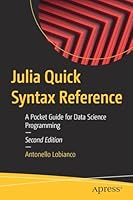
NoSQL For Dummies
- Length: 456 pages
- Edition: 1
- Language: English
- Publisher: For Dummies
- Publication Date: 2015-02-24
- ISBN-10: 1118905741
- ISBN-13: 9781118905746
- Sales Rank: #1204776 (See Top 100 Books)
Get up to speed on the nuances of NoSQL databases and what theymean for your organization
This easy to read guide to NoSQL databases provides the type ofno-nonsense overview and analysis that you need to learn, includingwhat NoSQL is and which database is right for you. Featuringspecific evaluation criteria for NoSQL databases, along with a lookinto the pros and cons of the most popular options, NoSQL ForDummies provides the fastest and easiest way to dive into thedetails of this incredible technology. You’ll gain an understandingof how to use NoSQL databases for mission-critical enterprisearchitectures and projects, and real-world examples reinforce theprimary points to create an action-oriented resource for ITpros.
If you’re planning a big data project or platform, you probablyalready know you need to select a NoSQL database to complete yourarchitecture. But with options flooding the market and updates andadd-ons coming at a rapid pace, determining what you require now,and in the future, can be a tall task. This is where NoSQL ForDummies comes in! * Learn the basic tenets of NoSQL databases and why they havecome to the forefront as data has outpaced the capabilities ofrelational databases * Discover major players among NoSQL databases, includingCassandra, MongoDB, MarkLogic, Neo4J, and others * Get an in-depth look at the benefits and disadvantages of thewide variety of NoSQL database options * Explore the needs of your organization as they relate to thecapabilities of specific NoSQL databases
Big data and Hadoop get all the attention, but when it comesdown to it, NoSQL databases are the engines that power many bigdata analytics initiatives. With NoSQL For Dummies, you’llgo beyond relational databases to ramp up your enterprise’s dataarchitecture in no time.
Table of Contents
Part I Getting Started with NoSQL
Chapter 1 Introducing NoSQL: The Big Picture
Chapter 2 NoSQL Database Design and Terminology
Chapter 3 Evaluating NoSQL
Part II Key-Value Stores
Chapter 4 Common Features of Key-Value Stores
Chapter 5 Key-Value Stores in the Enterprise
Chapter 6 Key-Value Use Cases
Chapter 7 Key-Value Store Products
Chapter 8 Riak and Basho
Part III Bigtable Clones
Chapter 9 Common Features of Bigtables
Chapter 10 Bigtable in the Enterprise
Chapter 11 Bigtable Use Cases
Chapter 12 Bigtable Products
Chapter 13 Cassandra and DataStax
Part IV Document Databases
Chapter 14 Common Features of Document Databases
Chapter 15 Document Databases in the Enterprise
Chapter 16 Document Database Use Cases
Chapter 17 Document Database Products
Chapter 18 MongoDB
Part V Graph and Triple Stores
Chapter 19 Common Features of Triple and Graph Stores
Chapter 20 Triple Stores in the Enterprise
Chapter 21 Triple Store Use Cases
Chapter 22 Triple Store Products
Chapter 23 Neo4j and Neo Technologies
Part VI Search Engines
Chapter 24 Common Features of Search Engines
Chapter 25 Search Engines in the Enterprise
Chapter 26 Search Engine Use Cases
Chapter 27 Types of Search Engines
Chapter 28 Elasticsearch
Part VII Hybrid NoSQL Databases
Chapter 29 Common Hybrid NoSQL Features
Chapter 30 Hybrid Databases in the Enterprise
Chapter 31 Hybrid NoSQL Database Use Cases
Chapter 32 Hybrid NoSQL Database Products
Chapter 33 MarkLogic
Part VIII The Part of Tens
Chapter 34 Ten Advantages of NoSQL over RDBMS
Chapter 35 Ten NoSQL Misconceptions
Chapter 36 Ten Reasons Developers Love NoSQL







